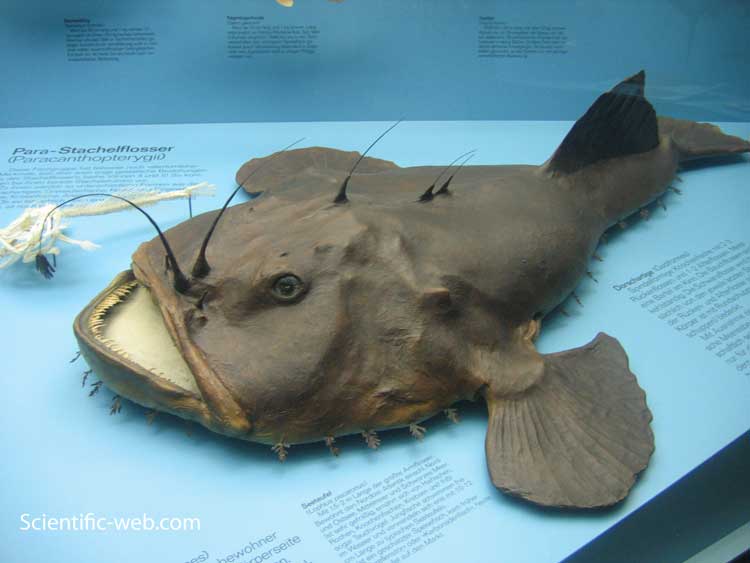
Lophius piscatorius, Photo: Michael Lahanas
Superregnum: Eukaryota
Cladus: Unikonta
Cladus: Opisthokonta
Cladus: Holozoa
Regnum: Animalia
Subregnum: Eumetazoa
Cladus: Bilateria
Cladus: Nephrozoa
Superphylum: Deuterostomia
Phylum: Chordata
Subphylum: Vertebrata
Infraphylum: Gnathostomata
Megaclassis: Osteichthyes
Superclassis/Classis: Actinopterygii
Classis/Subclassis: Actinopteri
Subclassis/Infraclassis: Neopterygii
Infraclassis: Teleostei
Megacohors: Osteoglossocephalai
Supercohors: Clupeocephala
Cohors: Euteleosteomorpha
Subcohors: Neoteleostei
Infracohors: Eurypterygia
Sectio: Ctenosquamata
Subsectio: Acanthomorphata
Divisio/Superordo: Acanthopterygii
Subdivisio: Percomorphaceae
Series: Eupercaria
Ordo: Lophiiformes
Subordo: Lophioidei
Familia: Lophiidae
Genus: Lophius
Species: Lophius piscatorius
Name
Lophius piscatorius Linnaeus, 1758
References
Linnaeus, C. 1758. Systema Naturae per regna tria naturæ, secundum classes, ordines, genera, species, cum characteribus, differentiis, synonymis, locis, Tomus I. Editio decima, reformata. Holmiæ: impensis direct. Laurentii Salvii. i–ii, 1–824 pp DOI: 10.5962/bhl.title.542: 236. Reference page.
Lophius piscatorius – Taxon details on Integrated Taxonomic Information System (ITIS).
Lophius piscatorius in the World Register of Marine Species
Vernacular names
asturianu: Pixín
azərbaycanca: Dəniz şeytanı, fənər balığı
brezhoneg: Boultouz
català: Rap
corsu: Rospu
čeština: Ďas mořský
dansk: Havtaske
Deutsch: Seeteufel, Angler, Anglerfisch, Lotte
Ελληνικά: Πεσκανδρίτσα, Πεσκαντρίτσα
English: Angler, Anglerfish, Monkfish,
Esperanto: Lofio
español: Rape común, Rape
eesti: Euroopa merikurat
euskara: Zapo zuri
suomi: Merikrotti
føroyskt: Havtaska
français: Baudroie commune, Lotte
galego: Peixe sapo
hrvatski: Grdobina mrkulja, Grdobina, Vrag, Rošpo, Vražica, Žaba
magyar: Európai horgászhal, Horgászhal, Ördöghal, Szerzetes hal
íslenska: Skötuselur
italiano: Rana pescatrice, Coda di rospo, Rospo
ქართული: ზღვის ეშმაკი
Ligure: Budego
Nederlands: Zeeduivel
norsk nynorsk: Breiflabb
norsk: Breiflabb
polski: Żabnica
português: Peixe-pescador
română: Drac de mare, Pește pescar, Ppește undițar
русский: Европейский удильщик
srpskohrvatski / српскохрватски: Grdobina mrkulja
slovenščina: Morska žaba
shqip: Peshkatar, Zhabë peshkatare, Hënëz, Peshku murg
svenska: Marulk
Türkçe: Fener balığı
українська: Морський чорт
中文: 釣鮟鱇
Lophius piscatorius, commonly known as the angler, European angler or common monkfish, is a monkfish in the family Lophiidae. It is found in coastal waters of the northeast Atlantic, from the Barents Sea to the Strait of Gibraltar, the Mediterranean and the Black Sea. Within some of its range, including the Irish Sea, this species comprises a significant commercial fishery.[2]
Description
It has a very large head which is broad, flat, and depressed; the rest of the body appears to be a mere appendage. The wide mouth extends all the way around the anterior circumference of the head, and both jaws are armed with bands of long, pointed teeth. These are inclined inwards and can be closed so as to offer no impediment to an object gliding towards the stomach, but to prevent its escape from the mouth.[3]
The pectoral and pelvic fins are so articulated as to perform the functions of feet, so the fish is able to walk along the bottom of the sea, where it generally hides in the sand or amongst seaweed. Around its head and also along the body, the skin bears fringed appendages resembling short fronds of seaweed, a structure which, combined with the extraordinary faculty of assimilating the colour of the body to its surroundings, assists this fish greatly in camouflaging itself in the places which it selects on account of the abundance of prey. It has no scales.[3]
Angling
Skeleton at the Muséum de Toulouse
Illustration from 1911
The fish has long filaments along the middle of its head, which are, in fact, the detached and modified three first spines of the anterior dorsal fin. The filament most important to the angler is the first, which is the longest, terminates in a lappet, and is movable in every direction. The angler is believed to attract other fish by means of its lure, and then to seize them with its enormous jaws. While it is considered probable that smaller fish are attracted in this way experiments have shown that the actions of the jaw is automatic and depends on the contact of the prey with the tentacle. Its stomach is expandable and it is not unknown for these fish to swallow prey of their own size.[3]
Lifecycle
The spawn of the angler consists of a thin sheet of transparent gelatinous material 60 to 90 cm (2 to 3 ft) wide and 7.5–9 m (25–30 ft) long drifting freely in the water. The eggs in this sheet are in a single layer, each in its own little cavity. The larvae are free-swimming and their pelvic fins are elongated into filaments.[3] A male angler matures at the age of 4 years and grows to be 40 cm (16 in) long; whereas the female angler takes 2 years longer to mature.[4]
References
Arnold, R. (2015). "Lophius piscatorius". IUCN Red List of Threatened Species. 2015: e.T198610A21911225. doi:10.2305/IUCN.UK.2015-4.RLTS.T198610A21911225.en. Retrieved 12 November 2021.
C.Michael Hogan. (2011). Irish Sea. eds. P. Saundry & C.Cleveland. Encyclopedia of Earth. National Council for Science and the Environment. Washington DC Retrieved 11 April 2017.
One or more of the preceding sentences incorporates text from a publication now in the public domain: Chisholm, Hugh, ed. (1911). "Angler". Encyclopædia Britannica. Vol. 2 (11th ed.). Cambridge University Press. p. 15.
"Lophius piscatorius: Reproduction". bioweb.uwlax.edu. Retrieved 2020-03-06.
Molecular Phylogenetics and Evolution 38 (2006) 742–754
Retrieved from "http://en.wikipedia.org/"
All text is available under the terms of the GNU Free Documentation License

